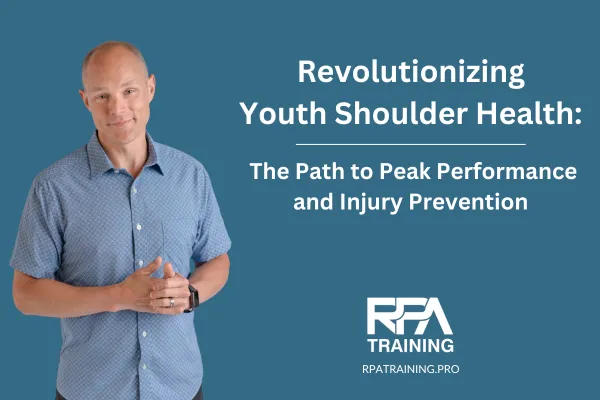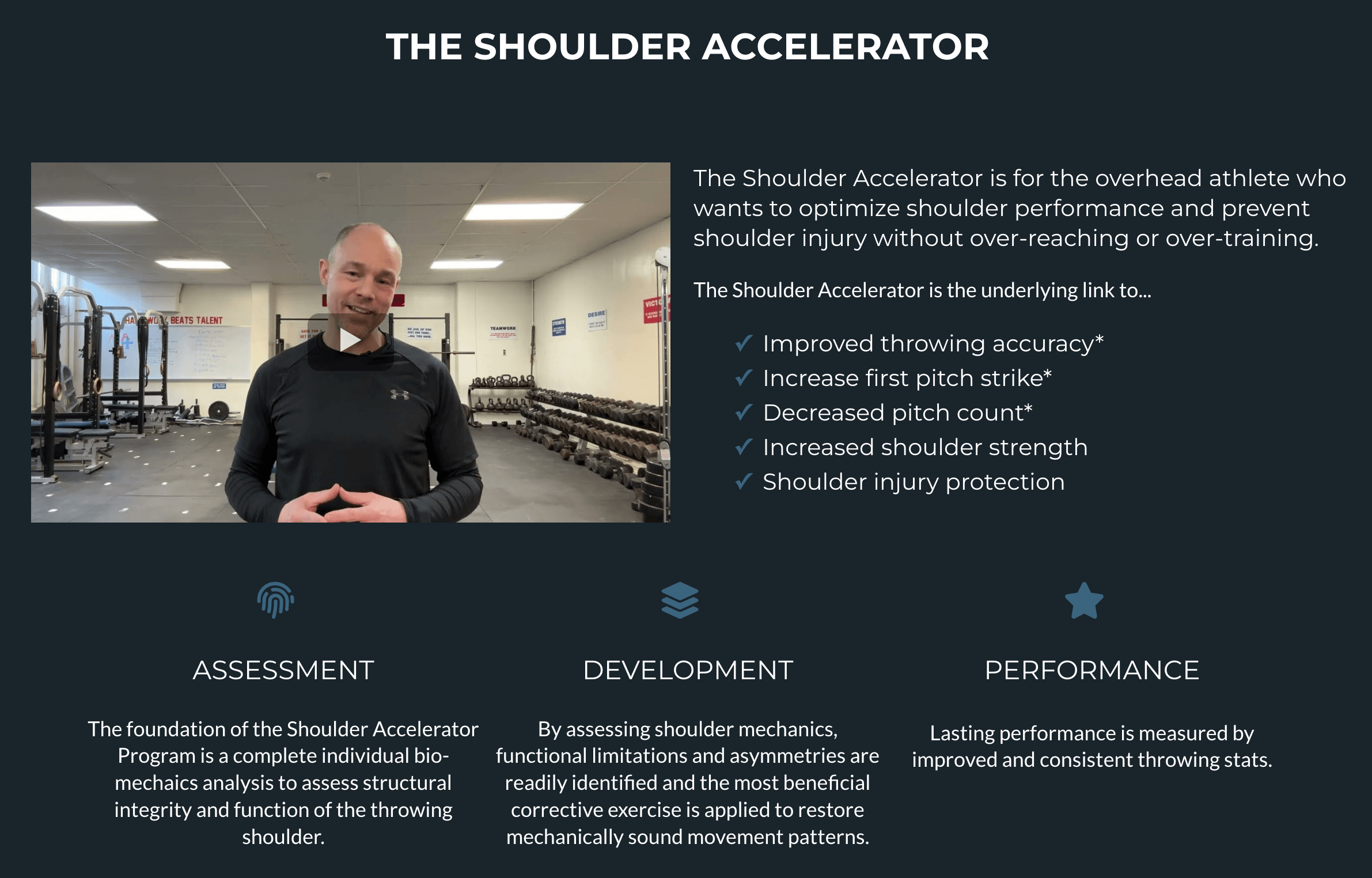
Revolutionizing Youth Shoulder Health: The Path to Peak Performance and Injury Prevention
“If something stands between you and your success, move it. Never be denied.” - Dwayne “The Rock” Johnson
In the fast-paced world of youth sports, every athlete is chasing greatness. But there's a catch - the ever-looming risk of getting hurt, especially when it comes to one of the most important yet fragile parts of an athlete's body: the shoulder. As more kids dive into overhead sports like baseball, volleyball, tennis, and swimming, we're seeing more shoulder injuries than ever before. That's where the Shoulder Accelerator Program comes in. It's a game-changer, designed to not just boost performance but also protect those precious shoulders from the typical injuries that can throw a wrench in an athlete's journey.
The Growing Concern of Shoulder Injuries in Young Athletes:
Lately, we've been seeing a worrying trend in youth sports - shoulder injuries are on the rise, and it's something we can't ignore. A lot of young athletes are dealing with pain, not performing their best, and some are even facing long-term issues. Why? Well, it boils down to overdoing it, not getting the mechanics right, and missing out on crucial preventive measures. Overhead sports are tough on the shoulders, leading to problems like rotator cuff tendinitis, instability, and injuries to the growth plate. These issues can really throw a young athlete off their game, affecting their growth in the sport and how far they can go in their careers.
The Big Picture on Overuse Injuries:
Let's talk about why we're seeing more and more shoulder issues in young athletes. It's mainly due to overuse injuries. Sports that have kids constantly moving their arms overhead, like baseball, volleyball, and swimming, really put a strain on those shoulder joints. This can lead to nasty stuff like tendinitis and bursitis. In fact, stats show that more than half of athletes in these sports will deal with shoulder pain at some point. That's a number we can't ignore
When Mechanics Go Wrong:
Another big player in the injury game is faulty biomechanics. Basically, if an athlete's technique or posture is off, it can throw everything out of balance, putting extra stress on the shoulder. Take a pitcher, for example. If their throwing mechanics are off, it's not just their game that suffers—it's their shoulder health too. But here's some good news: fixing these biomechanical issues can cut the risk of injury by up to 30%.
Looking Beyond the Usual Suspects:
Sure, overuse and mechanics are the usual suspects, but there's more to the story. Not getting enough rest, skipping out on preseason conditioning, and sticking to just one sport can all make shoulder injuries more likely. It's like putting all your eggs in one basket—eventually, something's going to give.
Performance Hits:
Now, how does all this affect an athlete's game? Well, things like the angle at which they throw or serve and how fast they move can really make or break their performance. If an athlete starts changing how they throw to dodge pain, they're also messing with their success on the field. Plus, injuries tend to slow things down, literally. Athletes with shoulder issues often see a drop in their speed, which is a double whammy—hurting both their play and their health.
The Strength Training Paradox:
Strength training is key for athletes looking to level up, but it's a bit of a tightrope walk. Overhead weight lifting, when done wrong, can be more harmful than helpful. It's all too easy for eager young athletes to push too hard or use bad form, putting their shoulders at risk. That's why having someone show them the ropes, focusing on technique, is so crucial.
The uptick in shoulder injuries among young athletes is a call to action. We need a game plan that tackles the root causes—overuse, biomechanics gone awry, and the pressures of specializing too early. That's where initiatives like the Shoulder Accelerator Program come into play. By honing in on proper technique, building strength the right way, and prioritizing injury prevention, we're not just protecting athletes' shoulders—we're setting them up for long-term success in their sports. Let's make sure our young athletes can play hard, play smart, and most importantly, play on.
Spotting the Early Signs: Your First Move Against Shoulder Injuries
It's clear that dodging shoulder injuries isn't just ideal—it's crucial. The real game-changer? Catching those early warning signs. It's all about spotting trouble before it sidelines you, ensuring athletes can bounce back faster and keep their performance on track. Especially for those constantly in action, like throwing or serving, paying attention to these early signals is key to staying ahead of the game.
What to Keep an Eye Out For:
Pain or Discomfort: The initial stages of a shoulder injury often manifest as pain during or after intense activity. If pain becomes your constant workout buddy, especially after intense sessions, it's time to listen up. That's your body's way of waving a red flag.
Struggling with Simple Moves: When simple movements become a struggle, it's a clear indication that the shoulder is not functioning as it should. Difficulty in reaching overhead or behind could suggest the onset of a shoulder injury.
Feeling Weaker: If lifting, throwing, or even just moving around starts to feel tougher, don't brush it off. Your shoulder might be telling you it's in trouble.
Tightness and Stiffness: A shoulder that feels tight and lacks flexibility can significantly restrict movement, hinting that something's not right.
Swelling and Tenderness: Noticeable swelling or tenderness around your shoulder? That's your cue to take a closer look.
Popping or Cracking Sounds: Such sounds during movement may not always signal a serious injury but if associated with discomfort or other symptoms, it's time for a closer look.
Feeling Loose: A sensation of the shoulder being loose or at risk of dislocating suggests ligament or labral concerns that need immediate evaluation.
Fatigue: Shoulders that get tired too quickly, especially from activities that were previously manageable, might be compensating for weakened conditions, indicating overuse.
Change in Your Game: Any unexpected changes in how you throw or lift, especially if you're trying to dodge pain, can mess with your shoulder and your performance.
Pain That Kills Your Sleep: Waking up because of shoulder pain, or pain that gets worse at night, is often a telltale sign of a deeper issue like a rotator cuff injury.
Making the Right Moves Early On:
Spotting these signs and getting them checked out isn't just smart—it's essential for keeping you in play. An early heads-up means you can tackle the issue head-on with the right treatment, cutting down recovery time and keeping you from sitting on the sidelines.
As we tackle shoulder injuries in youth sports, it's all about staying informed and proactive. Teaching athletes, along with their parents and coaches, to recognize these signs means everyone's ready to act fast. It's not just about preventing injuries; it's about ensuring a stronger, healthier path for young athletes everywhere.
Why Jumping In Early Makes All the Difference for Young Athletes' Shoulders
When it comes to youth sports, especially those that keep those arms constantly moving overhead, keeping those shoulders in top shape is absolutely key. My passion for guiding young athletes towards healthier shoulders early on comes from knowing just how complex and demanding their sports can be on those critical joints. Crafting a shoulder program that zeroes in on scapular balance, rotator cuff strength, and core stability isn't just a nice-to-have—it's a must. And here's the scoop on why:
Stable Shoulders for the Win: Think of stability as your shoulder's best friend. By focusing on the muscles that keep your shoulder in place, we're making sure it stays aligned and ready for action, no matter how intense the game gets. This is your first line of defense against those nasty dislocations and injuries.
Moving Smoothly: Being able to move freely and efficiently is what helps athletes shine. With the right exercises, we're ensuring your shoulders can handle all sorts of movements, making overhead actions feel like a breeze. This isn't just about avoiding injuries; it's about upping your game in every sport that calls for a strong overhead swing or throw.
Keeping Injuries at Bay: When your shoulder is well-supported and balanced, it's better at handling the stresses of your sport without buckling under pressure. This means less time out with injuries and more time playing the sports you love. A preventative approach is crucial in keeping young athletes in the game, focusing on strengthening the shoulder and core to ward off the common ailments that sideline so many promising careers.
Rotator Cuff Strength: Those rotator cuff muscles? They're pivotal for precise, powerful movements. Strengthening them is about more than just injury prevention—it's about giving you the power and accuracy you need to excel.
Straightening Up: A lot of shoulder issues stem from poor posture. My program tackles this head-on, helping correct those slouchy habits and aligning your shoulder just right, setting you up for success in sports and life.
Boosting Performance: At the end of the day, it's all about performing your best. Athletes who dive into my shoulder care see real gains in strength, stamina, and how well their shoulder works as a whole. That means doing better in your sport, and who doesn't want that?
Bouncing Back Faster: Already dealing with a shoulder issue? My approach is designed to get you back in action quicker and stronger, making sure those past injuries don't keep haunting you.
Future-Proofing Your Shoulders: By ironing out those biomechanical kinks and building a solid shoulder and core, your setting up to tackle the demands of your sport head-on, with a lower risk of getting hurt down the line.
A Well-Oiled Kinetic Chain: It's all connected—strengthening your core plays a big part in how well your whole body handles the energy and forces from your sport. This means fewer injuries and better performance all around.
Jumping on these strategies early can really change the game for young athletes. It's not just about dodging injuries; it's about building a foundation for success in sports and keeping those shoulders strong and ready for whatever comes their way.
Meet the Shoulder Accelerator Program:
So, you want to tackle those shoulder challenges head-on and build some seriously strong shoulders? Say hello to the Shoulder Accelerator Program. This isn't just any program; it's been crafted especially for young athletes like you, pulling together wisdom from top sports medicine experts and years of hands-on experience in shoulder care. At its core, you'll find the "Core 4 x 3" system – that's my secret sauce. It's a lineup of twelve carefully chosen exercises designed to wake up, beef up, and shield your shoulder muscles, making sure they're ready for whatever your sport throws at them.

Diving Into Core 4 x 3: What's It All About?
Let's zoom in on what makes the Core 4 x 3 tick. First off, we don't jump straight into exercises. We kick things off with a deep dive into how your shoulder moves, pinpointing exactly what you need and what we need to watch out for. Then, step by step, we walk you through exercises that get your scapula (that's your shoulder blade) and rotator cuff in tip-top shape, making sure your shoulder's getting strong in all the right ways. It's this step-by-step journey that not only amps up your game but also gets you thinking about how to keep those shoulders safe and sound, seriously cutting down your chances of getting hurt.

Why the Shoulder Accelerator Program is a Game-Changer
Here's the deal: sitting around waiting for shoulder pain to kick in before you do something about it? That's not how we roll with the Shoulder Accelerator Program. The truth is, a lot of shoulder issues start way before the pain shows up, hidden behind all those little adjustments your body makes to keep you moving. These sneaky imbalances and limitations? They're setting you up for trouble down the line. That's why we're big on stepping in early and getting smart about how we take care of your shoulders, aiming to get everything working just right, right from the start.
The Wins You Get with the Shoulder Accelerator Program
Jumping into this program, you're not just getting random exercises. You're getting a master plan designed to make your shoulders strong, stable, and ready to take on whatever your sport throws at them. And while we might not have a single study that ties all the benefits together, we've got plenty of research and expert knowledge backing up the wins you can expect.
Shoulder Strength and Stability: At the core of everything we do is making your shoulders as strong and stable as can be. We're talking exercises that zero in on the rotator cuff and those all-important stabilizers, giving you the kind of shoulder strength that not only ups your game but also keeps injury at bay.
Throwing Like a Pro: With a solid, stable shoulder comes the kind of throwing accuracy that can change the game. Even if we don't have a study linking our program directly to nailing every throw, the logic is solid: stronger, more stable shoulders mean you can throw more consistently and accurately.
Nailing the First-Pitch Strike Rate: Sure, we might not have the hard data linking stronger shoulders to hitting those first-pitch strikes, but connect the dots: better shoulder strength means better control, and better control means you're setting the pace right from the start.
Keeping the Pitch Count Down: By honing in on how you throw and building up your core, we're all about getting you to your performance goals without overdoing it. Fewer pitches mean less wear and tear, which means a longer, healthier time in the sport you love.
Protecting Your Shoulders: With a focus on the right exercises for your rotator cuff and stabilizers, we're building a fortress around your shoulders, keeping those common injuries at bay and letting you play with peace of mind.
Bouncing Back Better: And if you're coming back from an injury? This program is your comeback story, blending the best of rehab with performance training to not just get you back in the game but make you better than ever.
How Parents and Coaches Make All the Difference:
Hey, parents and coaches! You're the MVPs when it comes to guiding our young athletes on their journey. Spotting early signs of shoulder trouble and championing the cause for prevention can make a world of difference. Steering them towards resources like the Shoulder Accelerator Program is a game-changer. Plus, schooling them on the right way to warm up, the need for adequate rest, and the benefits of mixing up their training can really amplify what the program's all about, fostering an all-around growth environment for these budding sports stars.
Wrapping It Up:
The Shoulder Accelerator Program is more than just a step forward in how we look after young athletes' shoulders—it's a giant leap. Tackling the real reasons behind shoulder injuries and paving a clear path to building stronger, more resilient shoulders, we're setting new benchmarks in sports healthcare. And as we keep sharing what we learn and celebrate the wins, we're not just boosting individual athletes. We're aiming to kickstart a whole movement towards smarter, preventive care and smashing performance goals in youth sports.
Your Move:
So, what do you say? Ready to change the game when it comes to shoulder health? Whether you're hitting the field, cheering from the sidelines, or calling the shots as a coach, let's get on board with the Shoulder Accelerator Program. Book a chat with us, and let's kick off this journey to peak performance and injury-free sports. Together, we're not just dreaming of a brighter, healthier future for our young athletes—we're making it happen.

The weight training culture for youth athletes has attached itself to teams, organizations, schools, and individuals. The paradigm is caught between the traditional styles of weight lifting and the modern concepts of athletic development. The certainty is that we are seeing epidemic numbers in injuries across the youth sports demographic.
This guide demonstrates the 5 WEIGHT LIFTING TECHNIQUES THAT ABSOLUTELY DESTROYS SHOULDERS.
You will learn what exercises NOT TO DO as well as parts of the shoulder these exercises can do damage.
Download a copy here 👉 https://www.rpatraining.pro/the-donts-of-weight-training-ebook
The Shoulder Accelerator
Emerging Evidence on Overuse Injuries
Article discusses overuse injuries involving growing bone and soft tissues in adolescents participating in running-related sports.
URL: https://www.ncbi.nlm.nih.gov/pmc/articles/PMC8432296/
Risk Factors and Prevention Strategies for Shoulder Injuries
Identifies modifiable and non-modifiable factors associated with shoulder injury risk in overhead sports.
URL: https://www.ncbi.nlm.nih.gov/pmc/articles/PMC9378805/
Update on Preventing Overuse Injuries in Youth Athletes
Describes sports-specific and generalized strategies for the prevention of overuse injuries.
URL: https://link.springer.com/article/10.1007/s40141-022-00362-7
Shoulder Biomechanics in Normal and Selected Pathological Conditions
Highlights the importance of balanced glenohumeral and scapular force couples in shoulder rehabilitation.
URL: https://www.ncbi.nlm.nih.gov/pmc/articles/PMC7484714/
Childhood and Adolescent Sports-Related Overuse Injuries
Focuses on "Little league shoulder" as a common overuse injury among young male pitchers.
URL: https://www.aafp.org/pubs/afp/issues/2023/1200/sports-related-overuse-injuries.html
Risk Factors of Overuse Shoulder Injuries in Overhead Athletes: A Systematic Review
Examines intrinsic factors and previous injuries as significant risk factors for future shoulder injuries.
URL: https://www.ncbi.nlm.nih.gov/pmc/articles/PMC7485028/
Developing the Singapore Youth Shoulder Overuse Injury Prevention Program
Discusses an exercise program designed to reduce shoulder overuse injuries in overhead athletes.
URL: https://www.sciencedirect.com/science/article/pii/S1466853X23001402
The Epidemiology of Youth Sport-Related Shoulder Injuries: A Systematic Review
Reviews shoulder injury rates across various youth sports, suggesting the need for measures to reduce future injuries.
URL: https://www.hindawi.com/journals/tsmed/2022/8791398/
Adolescent Shoulder Injuries
Details injuries to the biceps-superior labrum complex from various occurrences, including overuse.
URL: https://link.springer.com/chapter/10.1007/978-3-319-56188-2_8
Overuse Injuries in Youth Sports: Biomechanical Considerations
Discusses the biomechanical considerations of overuse injuries in youth sports.
URL: https://www.researchgate.net/publication/11767043_Overuse_injuries_in_youth_sports_Biomechanical_considerations




